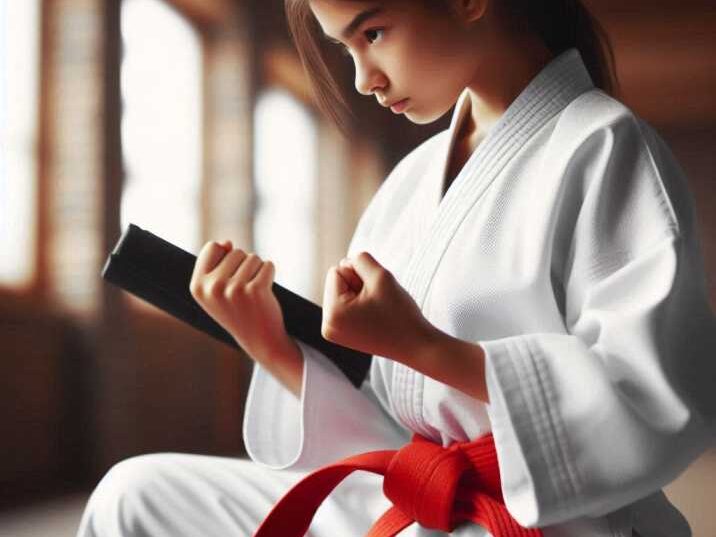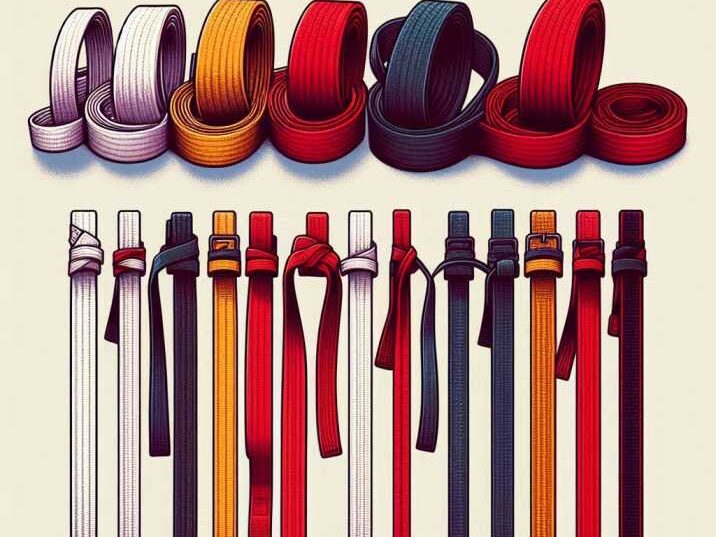Introduction
Table of Contents
Karate is more than just kicks and punches—it’s a way to build focus, discipline, and confidence. The red belt karate is a significant milestone in karate, often representing advanced skill and dedication. For young students, earning a red belt means mastering techniques while improving concentration in school and daily life.

What Is a Red Belt in Karate?
In many karate styles, the red belt is a high-ranking belt, often coming before the black belt. It signifies advanced skill, leadership, and deep understanding of martial arts.
🔴 What the Red Belt Means in Karate
🧠 A Sign of Mental Strength
The red belt is not just about fighting well. It shows the student has mental focus, discipline, and emotional control. In karate, students learn how to stay calm under pressure—just like a red belt!
👊 Almost a Master
Students with red belts are often just one or two levels away from the black belt. That means they have already spent years training and have shown they understand advanced moves and karate values.
📌 Karate Styles That Use the Red Belt
Not all karate styles use the same belt system. Some use the red belt in different ways:
🔹 Shotokan Karate
- Red belt is sometimes used for kids as a level before brown or black.
- In adult rankings, it’s not always used.
🔹 Taekwondo (Similar to Karate)
- Uses red as a high rank before black.
- Teaches self-control and respect for others.
🔹 Shito-Ryu & Goju-Ryu Karate
- Some schools use red for advanced children.
- Seen as a symbol of fire and strong spirit.
Karate Belt Ranking System
| Belt Color | Rank Level | Meaning |
|---|---|---|
| White | Beginner | Purity & new start |
| Yellow | Novice | Learning basics |
| Orange | Intermediate | Developing skills |
| Green | Advanced | Growth & improvement |
| Blue | Senior Student | Confidence & control |
| Purple | Expert | Refining techniques |
| Brown | Near-Master | Deep knowledge |
| Red | Advanced Expert | Leadership & precision |
| Black | Master | Highest achievement |
The red belt is a bridge between colored belts and the black belt, requiring discipline, patience, and hard work.

How Red Belt Karate Training Improves Focus & Discipline
1. Better Concentration in School
Karate training requires students to memorize complex forms (katas) and techniques, which sharpens their mental focus. Studies, such as one from the Journal of Pediatrics (2018), confirm that martial arts enhance attention span in children. The structured practice helps kids apply the same concentration skills in classrooms. Over time, this leads to improved academic performance and better listening habits.
2. Stronger Self-Discipline
To progress in karate, students must commit to regular practice and follow strict dojo rules. This routine instills self-discipline, teaching them the importance of consistency and effort. The ability to control impulses and stay focused translates into better behavior in school and at home. Kids learn that success comes from patience and hard work, not shortcuts.
3. Boosted Confidence
Earning a red belt is a major milestone that proves dedication pays off. As students master new skills, they gain self-confidence in their abilities. This confidence helps them face challenges—whether in sports, exams, or social situations—with a positive mindset. Many kids find that karate makes them braver in trying new things.
4. Improved Physical Fitness
Karate is a full-body workout that enhances strength, flexibility, and coordination. Kicks, punches, and stances build muscle while improving balance. Active kids have more energy, better sleep, and healthier habits. The physical benefits also support mental sharpness, making it easier to stay alert in school.
How to Train for a Red Belt in Karate
1. Master the Basics
Before advancing, students must perfect fundamental moves like stances, blocks, and strikes. Daily kata (form) practice ensures techniques become second nature. Strong basics create a solid foundation for complex red belt skills. Rushing leads to mistakes, so precision matters more than speed.
2. Develop Mental Strength
Karate isn’t just physical—it requires patience and perseverance. Students learn to push through frustration and keep practicing, even when progress feels slow. Techniques like meditation or breathing exercises help calm the mind and improve focus during training. Mental toughness separates good students from future black belts.
3. Train with a Good Instructor
A skilled sensei (teacher) provides proper guidance, corrects mistakes, and motivates students. Joining a reputable dojo ensures high-quality training with experienced mentors. Instructors also teach respect, humility, and the philosophy behind karate, not just techniques. Learning from the best speeds up progress.
4. Set Goals & Track Progress
Breaking training into small, achievable goals (e.g., mastering one kata per month) keeps students motivated. Celebrating small wins, like earning a stripe on their belt, boosts morale. Tracking progress in a journal helps identify strengths and areas to improve. Goal-setting teaches kids the value of long-term commitment.
🧱 The Role of Parents in Red Belt Karate
Parents play a huge part in their child’s karate journey, especially as they move closer to advanced levels like the red belt. Here’s how you can help:
✅ Encouraging Daily Practice
Daily practice helps students sharpen their skills and build muscle memory. Parents can support by setting a regular practice time and creating a quiet space at home. This consistency helps red belt students stay on track with their goals.
👀 Watching Their Classes
When parents attend karate classes, it shows kids that their hard work matters. Watching class helps parents understand what their child is learning, and it gives kids a sense of pride and motivation to improve.
🎯 Talking About Goals and Karate Values
Discussing goals like earning a black belt or improving a certain skill keeps kids focused and inspired. Talking about values like respect, discipline, and perseverance reinforces the life lessons karate teaches both inside and outside the dojo.
Fun Facts About Karate
✅ Karate originated in Okinawa, Japan, blending local fighting styles with Chinese martial arts. It became popular worldwide in the 20th century.
✅ “Karate” means “empty hand”—it emphasizes unarmed combat, though some styles use weapons like nunchaku or bo staffs.
✅ Red belts often assist in teaching, helping lower-ranked students learn basics. This builds leadership skills and reinforces their knowledge.
✅ Karate debuted in the 2020 Tokyo Olympics and will return in 2024 Paris, showcasing elite competitors in kata and kumite (sparring).
These points highlight how red belt karate shapes both the body and mind, preparing students for success beyond the dojo!
Conclusion
Earning a red belt in karate is a big achievement that builds focus, discipline, and confidence. For kids and teens, martial arts training helps in school, sports, and life. Whether you’re a beginner or aiming for a black belt, karate teaches valuable skills that last forever.
Ready to start your karate journey? Find a local dojo and begin training today!
FAQs About Red Belt Karate
1. How long does it take to earn a red belt?
It usually takes 4-6 years of consistent training.
2. Can kids earn a red belt?
Yes! Many kids achieve red belt with dedication.
3. Is red belt higher than black belt?
No, red belt is usually right before black belt.
4. What’s the hardest part of red belt training?
Mastering advanced katas and sparring techniques.
5. Does karate help with school grades?
Yes! Improved focus and discipline lead to better academic performance.


